

On March 1 of last year, Boeing Co. (NYSE: BA) stock posted an all-time high of $435.56. Two weeks later, the company’s 737 Max was grounded following two fatal crashes that killed 346 people and Boeing shares dropped nearly 20%.
That was the beginning of a share-price slide that reached a nadir in March of this year when shares closed at a multiyear low of $95.01. As the coronavirus outbreak spread from China to the rest of the world, airline traffic plummeted and a bad situation for Boeing got even worse.
All through 2019, even with the 737 Max grounded, the company continued to build new planes and park them at various locations around the country, anticipating a recertification and lifting of the grounding order. In January, the company shut down its 737 Max manufacturing line altogether, with more than 400 undelivered planes in its inventory.
That shutdown had a direct impact on Boeing employees and on many of Boeing’s suppliers. Spirit AeroSystems Holdings Inc. (NYSE: SPR), manufacturer of the 737 Max fuselage, shut down temporarily. Boeing’s engine suppliers have also had to adjust.
How Engine Suppliers Are Being Squeezed
Engines for Boeing’s commercial jets come from four suppliers: General Electric Co. (NYSE: GE); Raytheon Technologies Corp. (NYSE: RTX); Rolls-Royce; and CFM, a 50-50 joint venture between France’s Safran and GE. While all have felt the effects of Boeing’s 737 Max problems, how they will weather the COVID-19 pandemic remains an issue.
The hardest hit among these is GE. The pandemic has wreaked even more havoc on the company’s Aviation segment. In the fourth quarter of last year, the segment’s revenues totaled $8.9 billion and profit totaled $2.1 billion. Aviation is GE’s best moneymaker.
GE Aviation employed about 52,000 people at the end of 2019. On March 23, the company announced a permanent layoff of 10% of those employees and a 90-day layoff of half the segment’s service and maintenance staff. In all, some 6,750 employees were affected.
The United Kingdom’s Rolls-Royce continues to work on a fix for a fan-blade issue that temporarily grounded some Boeing 787 Dreamliners back in 2018. Boeing shut down the 787 line in March due to the COVID-19 outbreak and only restarted it earlier this week. Boeing also has announced a reduction in the production rate for the 787, from 14 a month to 10 per month this year and falling to seven per month in 2022.
The British engine maker is expected to cut its staff by about 250 workers this month. Rolls Royce also has announced that it plans to deliver just 250 widebody engines this year, down from an original plan to sell 450. Passenger traffic on widebody jets like the 787 and the Airbus A350 fell by 90% in April and is not expected to pick up anytime soon.
CFM manufactures the LEAP family of engines used on the 737 Max, the Airbus A320 and the new Chinese-built Comac C919. In the first quarter of this year, the company delivered 272 LEAP engines, a year-over-year decline of 35%. Most of that decline came before Airbus announced a halt to production.
Safran managed the 737 Max production halt pretty well, according to Safran CEO Philippe Petitcolin, but, “The situation we are facing today is of a different order of magnitude. It remains difficult, at this point, to measure precisely its far-reaching consequences.”
Raytheon Technologies, the result of a recently closed merger between Raytheon and United Technologies, like CFM, fared better, but that isn’t likely to last. The company, which kept UTC’s spot on the Dow Jones industrial average index, reported on May 7 that sales at its Pratt & Whitney jet engine division were up 11% year over year. The division’s operating margin, however, decreased from 9.0% in the year-ago quarter to 8.2% this year.
Pratt & Whitney’s geared turbofan engines are used on the Airbus A320neo family of narrowbody jets, among others. However, Airbus has run into the same production issues related to the coronavirus pandemic that Boeing faces and has halted production of new planes. Perhaps worse for Pratt & Whitney is that shop visits and maintenance are expected to be down by 50% this year.
Why All This Matters to Boeing
Keeping Boeing’s far-flung supply chain humming is no trivial task, even in good times. When Rolls-Royce had problems with faulty turbine blades in its Trent 1000 engine, it took Boeing’s 787 out of service for a while. A train derailment in Montana dumped several Spirit-built fuselages into a deep canyon while on their way to Washington to be completed.
Not only does Boeing need to deliver finished airplanes to its airline customers, the company needs to ensure that its suppliers can deliver the parts Boeing needs to build those planes. Once production resumes on the 737 Max, it is likely to require a couple of years to regain pre-grounding levels of production. If Boeing’s suppliers can’t keep pace because they’ve laid off too many people or caused big layoffs at their own suppliers, Boeing won’t recover as quickly as it needs to.
Sponsored: Find a Qualified Financial Advisor
Finding a qualified financial advisor doesn’t have to be hard. SmartAsset’s free tool matches you with up to 3 fiduciary financial advisors in your area in 5 minutes. Each advisor has been vetted by SmartAsset and is held to a fiduciary standard to act in your best interests. If you’re ready to be matched with local advisors that can help you achieve your financial goals, get started now.
Thank you for reading! Have some feedback for us?
Contact the 24/7 Wall St. editorial team.